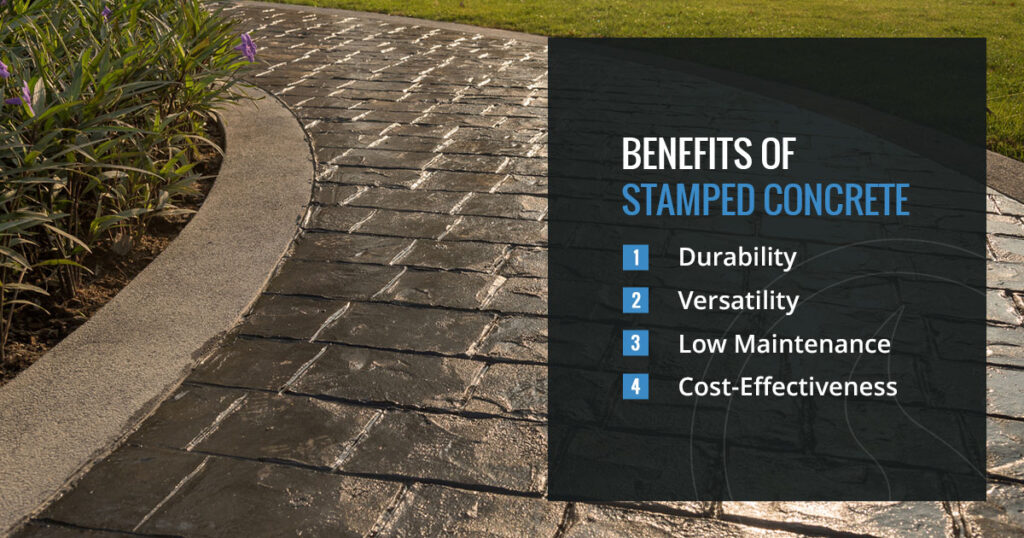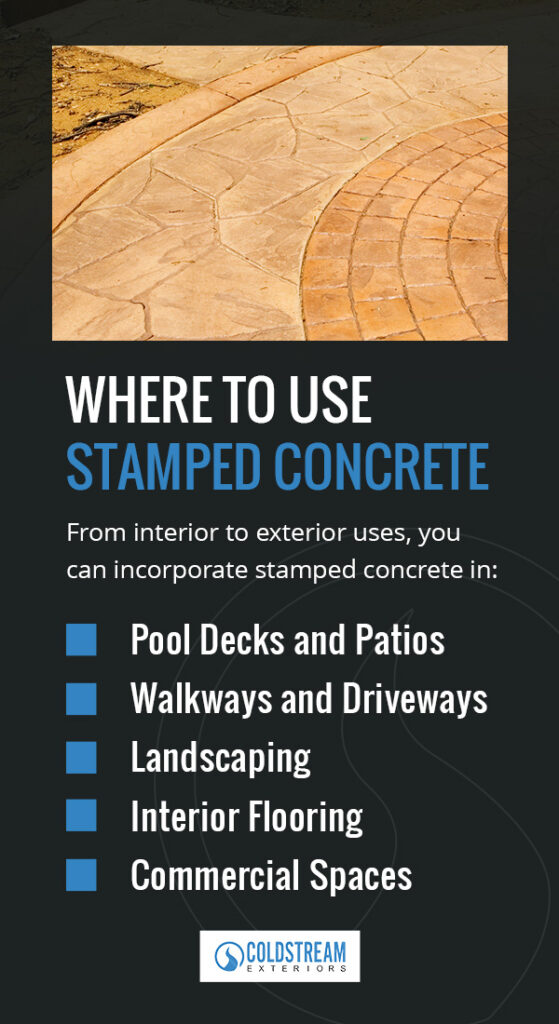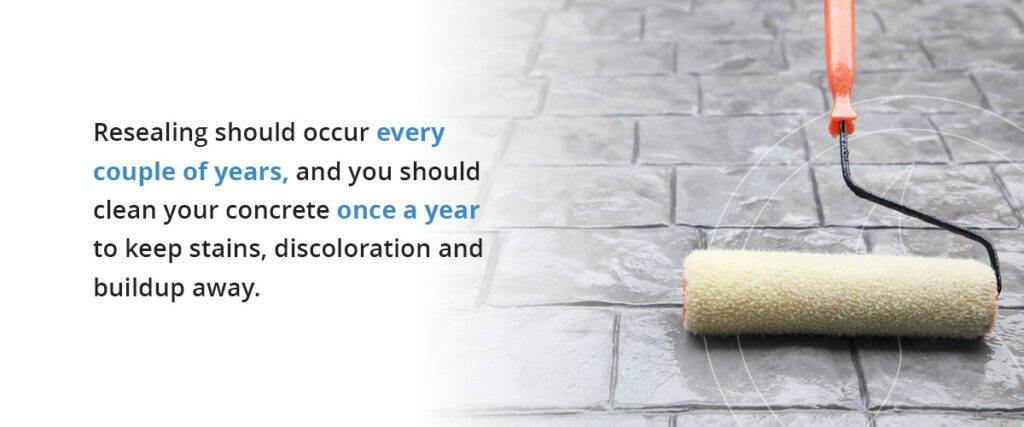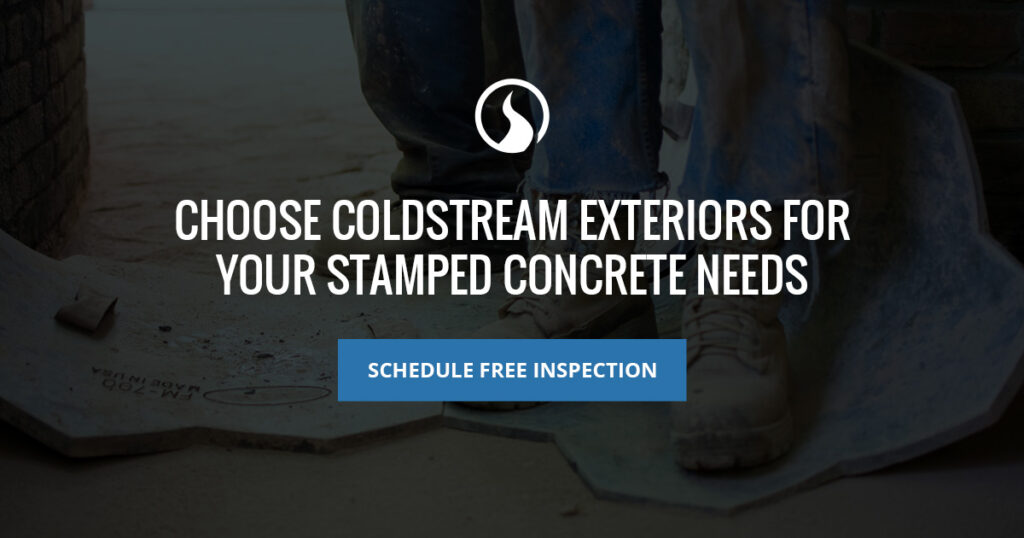What Is Stamped Concrete?

Finding the right material for your exterior patio, walkway or driveway can seem challenging. Balancing budget with design, maintenance and durability leaves you with lots of decisions to make. As a result, you may find yourself researching various materials to use for your next project.
Stamped concrete offers homeowners a straightforward alternative. It’s strong, long-lasting, low maintenance and can look like exactly as you wish. You can enjoy the look of any design or material while getting all the benefits of concrete for your home.
Understanding stamped concrete and how it can benefit you helps you find the best material or your next home exterior construction project. Read our guide below to learn more about what stamped concrete is, the different kinds of stamped concrete and how you can use it on your property.
Stamped Concrete Definition
Stamped concrete is concrete with a color, texture or pattern engrained into the material. These colors, textures and patterns allow the concrete to look like other less durable or more expensive materials. Stamped concrete gives you all the benefits of concrete with the appearance of different materials.
This option is often more affordable and durable than natural materials like wood, brick and stone. Stamped concrete is the more accessible and durable choice for most homeowners.
How Do You Stamp Concrete?
Stamping concrete involves imprinting the desired design on freshly-poured concrete. Specialized coloring agents, tools and molds allow craftspeople to print the concrete’s design. After pattern selection, the crafters print or stamp molds onto the fresh concrete’s surface, creating a unique design for the concrete. Once the design stamping is complete, the concrete goes through the curing process as usual.
Stamping must happen while the concrete is freshly-poured and still soft. Printing during the later curing stages will prove unsuccessful, as the concrete is too hard. Imprinting concrete this way allows you to get the look you want from your concrete without sacrificing durability.
Learning how to stamp concrete takes time and requires professional training. The curing process is a chemical process, and it’s essential to get it right or risk harming the concrete’s strength. You should only hire experts to complete your concrete jobs to ensure everything is done correctly and safely.

Benefits of Stamped Concrete
Stamped concrete is a popular exterior material because it’s attractive, cost-effective and lasting. While other materials can hold up to long-term use and weathering, concrete is one of the strongest materials used in exterior home projects.
With unmatched durability, lasting designs and excellent cost-effectiveness, stamped concrete is unmatched. Some of the many benefits you can expect to enjoy with stamped concrete include:
1. Durability
Strength and durability are some of the most significant selling points of stamped concrete. The curing process makes concrete extremely strong — it can withstand substantial forces and stressors without breaking. Concrete resists weathering and fading, so your stamped design will still look fresh long after the curing process finishes.
Regular maintenance and quality installation ensure your stamped concrete performs well for years.
2. Versatility
The customizability of stamped concrete makes it highly versatile. With unlimited textures, colors and patterns, you have endless design options for your home and can select the look you want without overspending. Stamped concrete is excellent for both interior and exterior projects — you can easily use stamped concrete to create elegant spaces inside and outside your home.
3. Low Maintenance
Pavers and wood require frequent maintenance — they need sealing and upkeep to ensure they stay in good condition while in use. Brick is more durable but needs more care than concrete to ensure everything holds up.
In comparison, stamped concrete is extremely low maintenance. Concrete only requires occasional cleaning and resealing to keep it looking good. Cleaning and resealing will help prevent discoloration and staining, while the concrete itself needs little help with remaining strong through weathering.
4. Cost-Effectiveness
Natural materials like hardwood and stone are much more expensive than stamped concrete. These materials cost more to source, install and maintain than stamped concrete. Additionally, more uncommon materials will drive your costs up even higher.
Concrete lasts years with proper installation — you can enjoy your concrete much longer without the added cost of hardwood or stone. It’s an extremely cost-effective material that allows you to get the most options and use it for your budget.
Stamped Concrete Styles
There are unlimited design possibilities for stamped concrete, so you can explore many stamped concrete types with your contractor, from natural looks to different pattern orientations.
Stamped concrete allows you to find the right look to complement your home. Your options will usually fall into these three categories:
- Natural designs: The most common style for stamped concrete is natural material-mimicking designs. Stone and hardwood are popular, while brick and cobblestone patterns reflect a more refined use of natural materials. Use custom accents and patterns with different-sized stones to create visually engaging, natural-looking walkways and designs.
- Pattern orientations: With stamped concrete’s convenience, you can easily change your pattern orientation. Vertical, horizontal and diagonal patterns are all possible. Additionally, you can use spacing and custom shapes to create patterns that are all your own.
- Color variety: Stamped concrete typically comes in a range of neutral colors to fit in with natural themes. Earth tones, grays and brick reds are the most popular colors, although the full-color range available to you depends on your contractor. Stamped concrete colors are easy to layer, stain and mix, allowing you to create the surface that best complements your home and tastes.

Where to Use Stamped Concrete
Stamped concrete has dozens of potential applications. With its versatility and durability, you can use it throughout your home for maximum strength and style. Picking the right material for your project is made simple with stamped concrete — it works well in many situations. From interior to exterior uses, you can incorporate stamped concrete in:
Pool Decks and Patios
Stamped concrete is durable and slip-resistant when a non-slip additive is mixed with the sealer, making it ideal for relaxation spaces like patios and pool decks. Stamped concrete is also durable and water-resistant — you won’t have to worry about water damage when using this material.
You can make these recreational areas elegant and comfortable using various colors, patterns and textures. Use stamped concrete to mimic natural stone or tile to add sophistication and timeless design to these spaces.
Walkways and Driveways
Driveways and walkways are some of the most common uses for stamped concrete. Thanks to its strength and wear resistance, stamped concrete is ideal for crafting attractive walkways and driveways for homes. Use stamped concrete to mimic classic stone or brick walkways while complementing your home’s color with a smooth stamped concrete driveway.
You’ll have to perform a little maintenance over the years, but nothing close to the maintenance requirements for other materials your stamped concrete mimics. Additionally, stamped concrete holds up against the heavy forces and wear of regular care use for years.
Landscaping
Stamped concrete is also excellent for landscaping projects. Because it can mimic natural materials without sacrificing durability, you can seamlessly integrate stamped concrete into your green space.
Use it for retaining walls, pathways and borders to cultivate your ideal home landscape without using materials that will not perform as well as stamped concrete. By incorporating stamped concrete into your landscaping, you can create a custom greenspace that withstands weathering and complements your home.
Interior Flooring
Stamped concrete also works well indoors. Use it for your next interior flooring project to give your home a modern feel. Striking flooring patterns can be stamped onto the concrete for statement pieces that tie your space together. The versatility of stamped concrete and its limitless design options mean you can use it for flooring in basements, kitchens, living rooms, laundry rooms and mudrooms.
Commercial Spaces
Stamped concrete is popular in commercial spaces for its versatility and durability. Restaurants, office buildings, hotels and retail stores all use stamped concrete to build custom themes. Stamped concrete enhances these spaces while providing the strength and low maintenance qualities they need from high-use areas.

How to Maintain Stamped Concrete
Stamped concrete is one of the most durable and low-maintenance exterior materials. You’ll still need to perform some maintenance to keep it in good shape, but you’ll do so less frequently than you would with other materials. Resealing should occur every couple of years, and you should clean your concrete once a year to keep stains, discoloration and buildup away. The more frequent the foot traffic and wear and the heavier the weathering, the more frequently you’ll need to perform these tasks.
To clean your stamped concrete, use water and mild detergent on the concrete. With a pressure washer and push broom, you can easily clear away all the dirt and grime your concrete accumulates over the year. Getting color hardeners and sealers for your stamped concrete will increase its resistance to stains, water and abrasions. Remove any grease or oil spills on your concrete immediately — this reduces the chances of staining and protects your concrete.
Does Stamped Concrete Fade?
The heavier the traffic and weathering on your concrete, the faster it’ll fade. Stamped concrete is highly fade-resistant, but wear and tear will eventually take its toll.
You can reduce color fading and change with regular cleaning and resealing. These practices will help restore the concrete’s color and protect it from further fading. Additionally, cleaning and resealing increase the time and wear it takes to fade your stained concrete. Cleaning and resealing can even bring neglected stained concrete back to life after years of poor maintenance.
Is Stamped Concrete Slippery?
Stamped concrete can be slippery when wet if it’s sealed without special additives. Non-slip additives can be mixed into the sealer before application, making the stamped concrete slip-resistant even after sealing. If you’re using stamped concrete for your patio or pool deck, consider requesting non-slip measures to ensure it’s safe to walk on.
Will Stamped Concrete Crack?
Stamped concrete is highly crack-resistant when installed correctly. Because improperly-installed concrete is prone to cracking and weakness, you must get a trusted professional to perform your installation. Without a professional contractor, your risk of cracks is much higher, and you’ll be dealing with an eyesore or a necessary replacement in the near future.
Minor cracks that blend into the concrete’s surface are more common. These won’t necessarily compromise the concrete’s performance. If your stamped concrete develops cracks after several years, you can use cement pastes and color patches to fill them in. If you see significant cracking after installation, contact your contractor for assistance.
Should You Use Salt on Stamped Concrete?
Deicing salt is often used to help prevent ice from forming on driveways and walkways. However, the chemicals in deicing salts create cycles of moisture freezing and thawing that can weaken your concrete. Rock salt may do less damage to your stamped concrete, although it can harm the environment.
If you need to protect your driveway or walkway from ice, use sand instead of salt. It won’t harm your stamped concrete like deicing salt, and it’s better for the nearby environment than rock salt. It has all the same traction and ice-prevention benefits without the potential for concrete damage.

Choose Coldstream Exteriors for Your Stamped Concrete Needs
With over 20 years of experience, you can trust Coldstream Exteriors to deliver the exterior concrete services you need. We offer professional concrete work for your home in the Greater Cincinnati area, along with roofing, window, siding and gutter services.
With locally-owned locations and high-quality materials, our expert teams provide our clients with unmatched exterior services and customer support. Additionally, we have industry-leading warranties and excellent financing options, so you can get the services and protections you need without breaking your budget.
Coldstream Exteriors is a Top Rated HomeAdvisor company with multiple Angie’s Super Service Awards and an A+ Better Business Bureau rating. If you’re interested in working with us for your next home exterior project, schedule your free inspection with us today!
